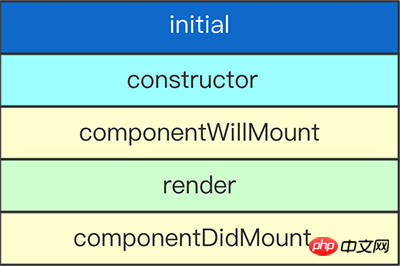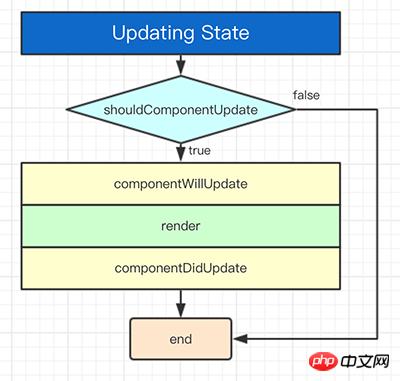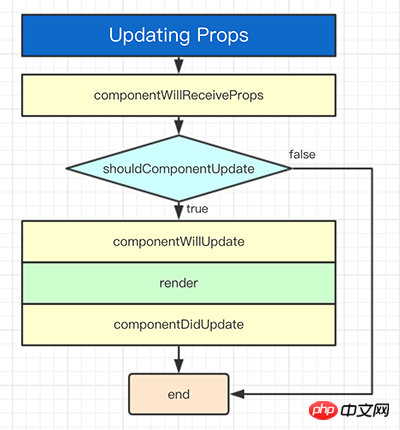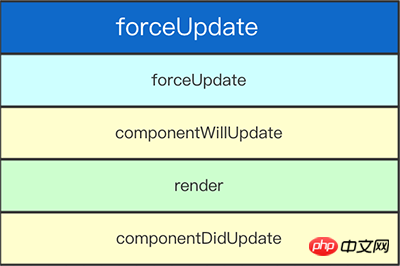Rumah >hujung hadapan web >tutorial js >React组件生命周期详解
React组件生命周期详解
- 小云云asal
- 2018-02-23 13:38:172331semak imbas
在使用React创建组件的过程中,会调用一个render方法,以及触发若干生命周期的方法。本文主要和大家讲一讲这些生命周期的方法是何时被执行的。
理解组件的生命周期,当组件被创建或销毁时,可以执行某些操作。此外,当 props 和 state 发生改变的时候,你可以利用这些生命周期的钩子来改变你的组件。
生命周期
为了清楚的了解生命周期,我们需要明白 组件初始化 ,state 改变 , props 改变 , 组件卸载 ,以及调用 forceUpdate() 时,哪些钩子函数会被执行。
组件初始化

constructor()
React组件的构造函数将会在装配之前被调用。当为一个React.Component子类定义构造函数时,你应该在任何其他的表达式之前调用super(props)。否则,this.props在构造函数中将是未定义。
构造函数是初始化状态的合适位置。若你不初始化状态且不绑定方法,那你也不需要为你的React组件定义一个构造函数。
可以基于属性来初始化状态。这样有效地“分离(forks)”属性并根据初始属性设置状态。这有一个有效的React.Component子类构造函数的例子:
constructor(props) {
super(props);
this.state = {
color: props.initialColor
};
}
componentWillMount()
componentWillMount()
componentWillMount()在装配发生前被立刻调用。其在render()之前被调用,因此在这方法里同步地设置状态将不会触发重渲。避免在该方法中引入任何的副作用或订阅。
这是唯一的会在服务端渲染调起的生命周期钩子函数。通常地,我们推荐使用constructor()来替代。
render()
render()方法是必须的。
当被调用时,其应该检查this.props 和 this.state并返回以下类型中的一个:
React元素。 通常是由 JSX 创建。该元素可能是一个原生DOM组件的表示,如
,或者是一个你定义的合成组件。字符串和数字。 这些将被渲染为 DOM 中的 text node。
Portals。 由 ReactDOM.createPortal 创建。
null。 什么都不渲染。
布尔值。 什么都不渲染。(通常存在于 return test &&
写法,其中 test 是布尔值。)
当返回null 或 false时,ReactDOM.findDOMNode(this) 将返回 null。render()函数应该纯净,意味着其不应该改变组件的状态,其每次调用都应返回相同的结果,同时不直接和浏览器交互。若需要和浏览器交互,将任务放在componentDidMount()阶段或其他的生命周期方法。保持render() 方法纯净使得组件更容易思考。
注意
若shouldComponentUpdate()返回false,render()函数将不会被调用。
componentDidMount()
componentDidMount()
componentDidMount()在组件被装配后立即调用。初始化使得DOM节点应该进行到这里。若你需要从远端加载数据,这是一个适合实现网络请求的地方。在该方法里设置状态将会触发重渲。
State Changes

shouldComponentUpdate()
shouldComponentUpdate(nextProps, nextState)
使用shouldComponentUpdate()以让React知道当前状态或属性的改变是否不影响组件的输出。默认行为是在每一次状态的改变重渲,在大部分情况下你应该依赖于默认行为。
当接收到新属性或状态时,shouldComponentUpdate()在渲染前被调用。默认为true。该方法并不会在初始化渲染或当使用forceUpdate()时被调用。
当他们状态改变时,返回false 并不能阻止子组件重渲。
注意:如果只定义方法,不写任何返回值,会提示:shouldComponentUpdate(): Returned undefined instead of a boolean value.
注意即使属性未有任何改变,React可能也会调用该方法,因此若你想要处理改变,请确保比较当前和之后的值。这可能会发生在当父组件引起你的组件重渲。
在装配期间,React并不会调用带有初始属性的componentWillReceiveProps方法。其仅会调用该方法如果某些组件的属性可能更新。调用this.setState通常不会触发componentWillReceiveProps。
componentWillUpdate()
componentWillUpdate(nextProps, nextState)
当接收到新属性或状态时,componentWillUpdate()为在渲染前被立即调用。在更新发生前,使用该方法是一次准备机会。该方法不会在初始化渲染时调用。
注意你不能在这调用this.setState(),若你需要更新状态响应属性的调整,使用componentWillReceiveProps()代替。
注意:若shouldComponentUpdate()返回false,componentWillUpdate()将不会被调用。
componentDidUpdate()
componentDidUpdate(nextProps, nextState)
当接收到新属性或状态时,componentWillUpdate()为在渲染前被立即调用。在更新发生前,使用该方法是一次准备机会。该方法不会在初始化渲染时调用。
注意:你不能在这调用this.setState(),若你需要更新状态响应属性的调整,使用componentWillReceiveProps()代替。注意:若
shouldComponentUpdate()返回false,componentWillUpdate()将不会被调用。
Props Changes

componentWillReceiveProps()
componentWillReceiveProps(nextProps)
componentWillReceiveProps()在装配了的组件接收到新属性前调用。若你需要更新状态响应属性改变(例如,重置它),你可能需对比this.props和nextProps并在该方法中使用this.setState()处理状态改变。
注意:即使属性未有任何改变,React可能也会调用该方法,因此若你想要处理改变,请确保比较当前和之后的值。这可能会发生在当父组件引起你的组件重渲。
在装配期间,React并不会调用带有初始属性的componentWillReceiveProps方法。其仅会调用该方法如果某些组件的属性可能更新。调用this.setState通常不会触发componentWillReceiveProps。
Unmounting

componentWillUnmount()
componentWillUnmount()
componentWillUnmount() 在组件被卸载和销毁之前立刻调用。可以在该方法里处理任何必要的清理工作,例如解绑定时器,取消网络请求,清理任何在componentDidMount环节创建的DOM元素。
forceUpdate

默认情况,当你的组件或状态发生改变,你的组件将会重渲。若你的render()方法依赖其他数据,你可以通过调用forceUpdate()来告诉React组件需要重渲。
调用forceUpdate()将会导致组件的 render()方法被调用,并忽略shouldComponentUpdate()。这将会触发每一个子组件的生命周期方法,涵盖,每个子组件的shouldComponentUpdate() 方法。若当标签改变,React仅会更新DOM。
通常你应该尝试避免所有forceUpdate() 的用法并仅在render()函数里从this.props和this.state读取数据。
forceUpdate() Example
// forceUpdate() Example
class App extends React.Component{
constructor(){
super();
this.forceUpdateHandler = this.forceUpdateHandler.bind(this);
};
componentWillUpdate() {
console.info('componentWillUpdate called');
}
componentDidUpdate() {
console.info('componentDidUpdate called');
}
forceUpdateHandler(){
this.forceUpdate();
};
render(){
return(
<p>
<button onClick= {this.forceUpdateHandler} >FORCE UPDATE</button>
<h4>Random Number : { Math.random() }</h4>
</p>
);
}
}
ReactDOM.render(<App />, document.getElementById('app'));
相关推荐:
Atas ialah kandungan terperinci React组件生命周期详解. Untuk maklumat lanjut, sila ikut artikel berkaitan lain di laman web China PHP!
Artikel berkaitan
Lihat lagi- Analisis mendalam bagi komponen kumpulan senarai Bootstrap
- Penjelasan terperinci tentang fungsi JavaScript kari
- Contoh lengkap penjanaan kata laluan JS dan pengesanan kekuatan (dengan muat turun kod sumber demo)
- Angularjs menyepadukan UI WeChat (weui)
- Cara cepat bertukar antara Cina Tradisional dan Cina Ringkas dengan JavaScript dan helah untuk tapak web menyokong pertukaran antara kemahiran_javascript Cina Ringkas dan Tradisional

